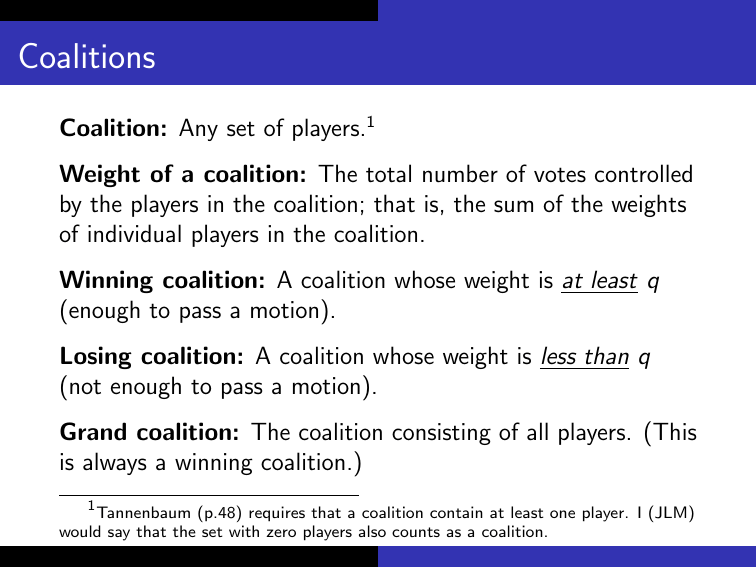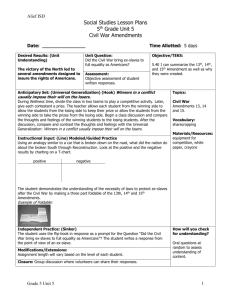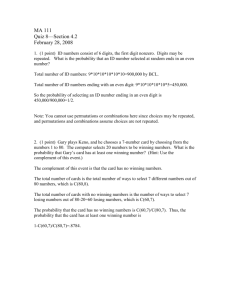Coalitions and the Banzhaf power index
advertisement

Coalitions
Coalition: Any set of players.1
Weight of a coalition: The total number of votes controlled
by the players in the coalition; that is, the sum of the weights
of individual players in the coalition.
Winning coalition: A coalition whose weight is at least q
(enough to pass a motion).
Losing coalition: A coalition whose weight is less than q
(not enough to pass a motion).
Grand coalition: The coalition consisting of all players. (This
is always a winning coalition.)
1
Tannenbaum (p.48) requires that a coalition contain at least one player. I (JLM)
would say that the set with zero players also counts as a coalition.
Coalitions
For example, in the WVS [58; 31, 31, 28, 21, 2, 2]:
I
{P2 , P3 , P5 } and {P1 , P4 , P5 , P6 } are coalitions
(sets of players).
I
{P2 , P3 , P5 } is a winning coalition because
w2 + w3 + w5 = 31 + 28 + 2 = 61 ≥ 58.
I
{P1 , P4 , P5 , P6 } is a losing coalition because
w1 + w4 + w5 + w6 = 31 + 21 + 2 + 2 = 56 < 58.
Counting Coalitions
How many different possible coalitions are there?
Counting Coalitions
How many different possible coalitions are there?
I
N = 1: 2 coalitions: {} and {P1 }.
Counting Coalitions
How many different possible coalitions are there?
I
N = 1: 2 coalitions: {} and {P1 }.
I
N = 2: 4 coalitions:
{}, {P1 }, {P2 }, {P1 , P2 }
Counting Coalitions
How many different possible coalitions are there?
I
N = 1: 2 coalitions: {} and {P1 }.
I
N = 2: 4 coalitions:
{}, {P1 }, {P2 }, {P1 , P2 }
I
N = 3: 8 coalitions:
{}, {P1 }, {P2 }, {P1 , P2 },
{P3 }, {P1 , P3 }, {P2 , P3 }, {P1 , P2 , P3 }
Counting Coalitions
How many different possible coalitions are there?2
If there are N players, there are 2N coalitions.
N
0
1
2
3
4
5
2N
1
2
4
8
16
32
N
6
7
8
9
10
20
2N
64
128
256
512
1024
1048576
2
This is if you count the coalition {}. If you follow Tannenbaum and require that a
coalition contain at least one player, then the formula would be 2N − 1 instead of 2N .
Coalition Tables
Coalition table: A list of all possible coalitions that indicates
which are winning and which are losing.
Example 1: [8; 5, 5, 4].
Coalition
{}
{P1 }
{P2 }
{P3 }
{P1 , P2 }
{P1 , P3 }
{P2 , P3 }
{P1 , P2 , P3 }
Total votes Winning/losing
0
Losing
5
Losing
5
Losing
4
Losing
10
Winning
9
Winning
9
Winning
14
Winning
Coalition Tables
Coalition table: A list of all possible coalitions that indicates
which ones are winning and which ones are losing.
Example 2: [10; 5, 5, 4].
Coalition
{}
{P1 }
{P2 }
{P3 }
{P1 , P2 }
{P1 , P3 }
{P2 , P3 }
{P1 , P2 , P3 }
Total votes Winning/losing
0
Losing
5
Losing
5
Losing
4
Losing
10
Winning
9
Losing
9
Losing
14
Winning
Coalition Tables
Coalition table: A list of all possible coalitions that indicates
which ones are winning and which ones are losing.
Example 3: [12; 5, 5, 4].
Coalition
{}
{P1 }
{P2 }
{P3 }
{P1 , P2 }
{P1 , P3 }
{P2 , P3 }
{P1 , P2 , P3 }
Total votes Winning/losing
0
Losing
5
Losing
5
Losing
4
Losing
10
Losing
9
Losing
9
Losing
14
Winning
Equivalence of Weighted Voting Systems
We can now tell when two weighted voting systems represent
the same allocation of power:
when the same coalitions are winning in both systems.
For example, let’s compare two apparently different WVS’s:
[10; 5, 5, 4] and [60; 44, 22, 11].
Equivalence of Weighted Voting Systems
[10; 5, 5, 4]
Coalition
{}
{P1 }
{P2 }
{P3 }
{P1 , P2 }
{P1 , P3 }
{P2 , P3 }
{P1 , P2 , P3 }
Total
W/L
[60; 44, 22, 11]
Total
W/L
Equivalence of Weighted Voting Systems
[10; 5, 5, 4]
Coalition
{}
{P1 }
{P2 }
{P3 }
{P1 , P2 }
{P1 , P3 }
{P2 , P3 }
{P1 , P2 , P3 }
Total
0
5
5
4
10
9
9
14
W/L
Losing
Losing
Losing
Losing
Winning
Losing
Losing
Winning
[60; 44, 22, 11]
Total
W/L
Equivalence of Weighted Voting Systems
[10; 5, 5, 4]
Coalition
{}
{P1 }
{P2 }
{P3 }
{P1 , P2 }
{P1 , P3 }
{P2 , P3 }
{P1 , P2 , P3 }
Total
0
5
5
4
10
9
9
14
W/L
Losing
Losing
Losing
Losing
Winning
Losing
Losing
Winning
[60; 44, 22, 11]
Total
0
44
22
11
66
55
33
77
W/L
Losing
Losing
Losing
Losing
Winning
Losing
Losing
Winning
Equivalence of Weighted Voting Systems
[10; 5, 5, 4]
Coalition
{}
{P1 }
{P2 }
{P3 }
{P1 , P2 }
{P1 , P3 }
{P2 , P3 }
{P1 , P2 , P3 }
Total
0
5
5
4
10
9
9
14
W/L
Losing
Losing
Losing
Losing
Winning
Losing
Losing
Winning
These two WVS’s are equivalent!
[60; 44, 22, 11]
Total
0
44
22
11
66
55
33
77
W/L
Losing
Losing
Losing
Losing
Winning
Losing
Losing
Winning
Dummies
Question: How can we detect dummies mathematically?
Dummies
Question: How can we detect dummies mathematically?
Answer: Player P is a dummy if there is no winning
coalition that P can turn into a losing coalition by
deserting.
Equivalently, P is a dummy if there is no losing coalition
that P can turn into a winning coalition by joining.
(A dummy can still be part of a winning coalition! But a
dummy’s presence or absence makes no difference to
whether or not the coalition is winning or losing.)
Dummies
Example: [10; 5, 5, 4].
I
The only winning coalitions are {P1 , P2 } and
{P1 , P2 , P3 } (the grand coalition)
I
The only winning coalition that includes P3 is the grand
coalition. . .
I
. . . and removing P3 still results in a winning
coalition, namely {P1 , P2 }.
I
Therefore, P3 is a dummy.
Dummies
Example: [12; 5, 5, 4].
I
Now the only winning coalition is {P1 , P2 , P3 }
(the grand coalition).
I
Removing P3 from the grand coalition results in a losing
coalition, namely {P1 , P2 }.
I
Therefore, P3 is not a dummy.
Dummies
Example: [8; 5, 5, 4].
I
There are four winning coalitions: {P1 , P2 }, {P1 , P3 },
{P2 , P3 }, and the grand coalition {P1 , P2 , P3 }.
I
Removing P3 from the winning coalition {P1 , P3 } results
in the losing coalition {P1 }.
I
Therefore, P3 is not a dummy.
Measuring Power
Question: How do we measure power using mathematics?
Idea: Measure how often each player in a WVS controls the
balance of power.
That is, for each player P, what is the likelihood that (a) P is
part of the winning coalition and that (b) P’s support is
necessary for that coalition to be a winning one?
Such a player is called critical for that winning coalition.
Critical Players
Example 1: [11; 7, 5, 4].
The winning coalitions and their weights are:
{P1 , P2 }
| {z }
weight 12
{P1 , P3 }
| {z }
weight 11
{P1 , P2 , P3 }
|
{z
}
weight 16
I
In {P1 , P2 }, the participation of P2 is necessary:
if P2 leaves the coalition, it becomes a losing one.
I
In {P1 , P2 , P3 }, the participation of P2 is not necessary:
if P2 leaves, then the coalition is still winning.
P2 is critical for {P1 , P2 }, but not for {P1 , P2 , P3 }.
Critical Counts and the Banzhaf Power Index
Example 1: [11; 7, 5, 4].
Winning Coalition
{P1 , P2 }
{P1 , P3 }
{P1 , P2 , P3 }
Weight
Critical Players
7+5
= 12
P1 , P2
7+4
= 11
P1 , P3
7 + 5 + 4 = 16
P1
Critical count = # of coalitions for which a player is critical.
The critical count for P1 is 3;
the critical counts for P2 and P3 are both 1.
Critical Counts and the Banzhaf Power Index
Winning Coalition
{P1 , P2 }
{P1 , P3 }
{P1 , P2 , P3 }
Player
P1
P2
P3
Total
Weight
Critical Players
7+5
= 12
P1 , P2
7+4
= 11
P1 , P3
7 + 5 + 4 = 16
P1
Critical Count
3
1
1
5
Critical Counts and the Banzhaf Power Index
Winning Coalition
{P1 , P2 }
{P1 , P3 }
{P1 , P2 , P3 }
Player
P1
P2
P3
Total
Weight
Critical Players
7+5
= 12
P1 , P2
7+4
= 11
P1 , P3
7 + 5 + 4 = 16
P1
Critical Count
3
1
1
5
Banzhaf power index
3/5
1/5
1/5
Measuring Power, Again
Idea: We can measure a player’s power by determining how
often that player is critical for some coalition.
I.e., how often does each player’s name appear in the
last column of the table?
I
Lionel Penrose (1946): “The Elementary Statistics of
Majority Voting”
I
John Banzhaf (1965): “Weighted Voting Doesn’t Work”
I
James Coleman (1971): “Control of Collectives and the
Power of a Collectivity to Act”
Banzhaf’s Article
Banzhaf’s article “Weighted Voting Doesn’t Work” (Rutgers
Law Review, vol. 19, 1965)
“In almost all cases weighted voting does not do
the one thing which both its supporters and
opponents assume that it does . . . voting power is
not proportional to the number of votes a legislator
may cast.”
“The purpose of this paper is neither to attack nor
defend weighted voting per se. As with any
objective mathematical analysis, its intent is only
to explain the effects which necessarily follow once
the mathematical model and the rules of its
operation are established.”
Banzhaf’s Article
Banzhaf analyzed the Nassau County Board of Supervisors —
the weighted voting system [58; 31, 31, 28, 21, 2, 2].
Banzhaf showed that, as we have seen, players P4 , P5 and P6
are dummies.
The article “Weighted Voting Doesn’t Work” became the
basis for a series of lawsuits (not a frequent achievement for
an article on mathematics!)
Calculating Banzhaf Power Indices
For any weighted voting system with N players:
1. Find all the winning coalitions.
2. For each one, determine the critical players.
3. Count the number of times that each player Pi is critical.
Call this number Bi .
4. The Banzhaf power index of Pi is
βi =
Bi
B1 + B2 + · · · + BN
The Banzhaf power distribution of the weighted voting
system is the complete list
(β1 , β2 , . . . , βN ).
Banzhaf Power: Example 1
Example 1: The weighted voting system [8; 5, 5, 4].
Winning Coalition
Weight
Critical Players
{P1 , P2 }
{P1 , P3 }
{P2 , P3 }
{P1 , P2 , P3 }
5+5
= 10
5+4
= 9
5+4
= 9
5 + 5 + 4 = 14
P1 , P2
P1 , P3
P2 , P3
None
Banzhaf Power: Example 1
I
Each of the three players has the same critical count:
B1 = B2 = B3 = 2.
I
Thus every player has the same Banzhaf power index.
The sum of all critical counts is T = 6, so
β1 = β2 = β3 =
2
1
= .
6
3
I
Therefore, the Banzhaf power distribution is
1 1 1
, ,
.
3 3 3
I
This confirms that all players have equal power!
Banzhaf Power: Example 2
Example 2: The weighted voting system [10; 5, 5, 4].
Winning Coalition
Weight
{P1 , P2 }
10
{P1 , P2 , P3 }
14
Critical Players
Banzhaf Power: Example 2
Example 2: The weighted voting system [10; 5, 5, 4].
Winning Coalition
Weight
Critical Players
{P1 , P2 }
10
P1 , P2
{P1 , P2 , P3 }
14
P1 , P2
Banzhaf Power: Example 2
Example 2: The weighted voting system [10; 5, 5, 4].
Winning Coalition
Weight
Critical Players
{P1 , P2 }
10
P1 , P2
{P1 , P2 , P3 }
14
P1 , P2
Player
P1
P2
P3
Bi
2
2
0
Total
T =4
Banzhaf power index
2/4 = 1/2
2/4 = 1/2
0
Banzhaf Power: Example 2
Example 2: The weighted voting system [10; 5, 5, 4].
Winning Coalition
Weight
Critical Players
{P1 , P2 }
10
P1 , P2
{P1 , P2 , P3 }
14
P1 , P2
Player
P1
P2
P3
Bi
2
2
0
Total
T =4
Banzhaf power index
2/4 = 1/2
2/4 = 1/2
0
← Dummy!
Banzhaf Power: Example 2
Conclusion: In the WVS [10; 5, 5, 4], the Banzhaf power
distribution is
(β1 , β2 , β3 ) = (1/2, 1/2, 0).
Therefore, player P3 is a dummy.
A player is a dummy if and only if his/her Banzhaf
power index is 0.
Banzhaf Power: Example 3
Example 3: The weighted voting system [12; 5, 5, 4]
Winning Coalition
{P1 , P2 , P3 }
I
Weight
5+5+4
=
Critical Players
14
P1 , P2 , P3
All players have the same critical count:
B1 = B2 = B3 = 1.
I
So all players have the same Banzhaf power index:
β1 = β2 = β3 = 1/3.
Banzhaf Power: Examples 1 and 3
I
In both [8; 5, 5, 4] and [12; 5, 5, 4], the Banzhaf power
distribution is
(β1 , β2 , β3 ) = (1/3, 1/3, 1/3).
I
Therefore, in each system, all players have the same
power.
I
But that does not necessarily mean that the voting
systems are equivalent.
(In the first case, a motion requires two players to agree;
in the second case, unanimous agreement is required.)
Banzhaf Power: Example 4
Example 4: Weighted voting system [22; 26, 5, 5, 4].
Banzhaf Power: Example 4
Example 4: Weighted voting system [22; 26, 5, 5, 4].
I
There are lots of winning coalitions — namely, those (and
only those) coalitions that contain player P1 (“Mom”).
Banzhaf Power: Example 4
Example 4: Weighted voting system [22; 26, 5, 5, 4].
I
I
There are lots of winning coalitions — namely, those (and
only those) coalitions that contain player P1 (“Mom”).
In each winning coalition, Mom is a critical player, but no
one else is.
Banzhaf Power: Example 4
Example 4: Weighted voting system [22; 26, 5, 5, 4].
I
I
I
There are lots of winning coalitions — namely, those (and
only those) coalitions that contain player P1 (“Mom”).
In each winning coalition, Mom is a critical player, but no
one else is.
Therefore, Mom’s Banzhaf power index is 1 (= 100%)
and everyone else’s Banzhaf power index is 0.
Banzhaf Power: Example 4
Example 4: Weighted voting system [22; 26, 5, 5, 4].
I
I
I
There are lots of winning coalitions — namely, those (and
only those) coalitions that contain player P1 (“Mom”).
In each winning coalition, Mom is a critical player, but no
one else is.
Therefore, Mom’s Banzhaf power index is 1 (= 100%)
and everyone else’s Banzhaf power index is 0.
A player is a dictator if and only if his/her Banzhaf
power index is 100%.
Banzhaf Power: Summary
I
The Banzhaf power index (BPI) of a player measures how
often that player is critical for some winning coalition.
βi =
I
I
I
Bi
critical count for player Pi
=
T
sum of critical counts for all players
The BPI of a dummy is always 0 (= 0%).
The BPI of a dictator is always 1 (= 100%).
If two players have the same Banzhaf power index, then
they really do have the same amount of power.
Banzhaf Power: Example 5
Example 5: In the weighted voting system [10; 8, 4, 2, 1],
what is the Banzhaf power distribution?
Banzhaf Power: Example 5
Example 5: In the weighted voting system [10; 8, 4, 2, 1],
what is the Banzhaf power distribution?
Winning Coalition
Critical Players
{P1 , P2 }
{P1 , P3 }
{P1 , P2 , P3 }
{P1 , P2 , P4 }
{P1 , P3 , P4 }
{P1 , P2 , P3 , P4 }
P1 , P2
P1 , P3
P1 , P2
P1 , P2
P1
P1
Banzhaf Power: Example 5
Example 5: In the weighted voting system [10; 8, 4, 2, 1],
what is the Banzhaf power distribution?
B1 = 6
Winning Coalition
Critical Players
{P1 , P2 }
{P1 , P3 }
{P1 , P2 , P3 }
{P1 , P2 , P4 }
{P1 , P3 , P4 }
{P1 , P2 , P3 , P4 }
P1 , P2
P1 , P3
P1 , P2
P1 , P2
P1
P1
B2 = B3 = 2
B4 = 0
T = 10
Banzhaf Power: Example 5
For the weighted voting system [10; 8, 4, 2, 1],
the Banzhaf power distribution is
(6/10, 2/10, 2/10, 0) = (3/5, 1/5, 1/5, 0).
I
I
I
P1 has veto power (he is critical for every winning
coalition).
P2 has the same amount of power as P3 .
P4 is a dummy (her Banzhaf power index is 0).
Example: The UN Security Council
The UN Security Council consists of
I 5 permanent members: China, France, Russia, United
Kingdom, USA
I 10 rotating members (currently: Bosnia/Herzegovina,
Brazil, Gabon, Lebanon, Nigeria, Colombia, Germany,
India, Portugal, South Africa)
Passing a motion requires at least nine votes, including all five
of the permanent members.
What is the Banzhaf power distribution?
(There must be a better way of doing this than having to
write out all 215 = 32, 768 coalitions!)
Example: The UN Security Council
Observations:
I
We don’t need to assign numerical weights — all we need
to do is figure out which coalitions are winning and which
ones are losing.
I
Each winning coalition must contain all five permanent
members, along with at least four rotating members.
I
Every permanent member has the same power as every
other permanent member.
Every rotating member has the same power as every
other rotating member.
I
Example: The UN Security Council
Permanent Members
I
Every permanent member (say, Russia) is critical for
every winning coalition.
I
Therefore, the critical count for Russia is just the total
number of winning coalitions, which is the number of
ways to choose at least four of the ten rotating
members.
I
Using permutations and combinations (coming soon!),
this number can be calculated as 848.
Example: The UN Security Council
Rotating Members
I
Each rotating member (say, Portugal) is critical for a
winning coalition only if there are exactly three other
rotating members.
I
Therefore, the critical count for Portugal is the number
of ways to choose exactly three of the nine other
rotating members.
I
Using permutations and combinations, this number can
be calculated as 84.
Example: The UN Security Council
5 permanent members, each with critical count 848
10 rotating members, each with critical count 84
Example: The UN Security Council
5 permanent members, each with critical count 848
10 rotating members, each with critical count 84
Banzhaf power index of each permanent member:
848
848
=
≈ 0.1669 = 16.69%
(5 × 848) + (10 × 84)
5080
Example: The UN Security Council
5 permanent members, each with critical count 848
10 rotating members, each with critical count 84
Banzhaf power index of each permanent member:
848
848
=
≈ 0.1669 = 16.69%
(5 × 848) + (10 × 84)
5080
Banzhaf power index of each rotating member:
84
84
=
≈ 0.0165 = 1.65%
(5 × 848) + (10 × 84)
5080








